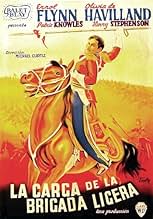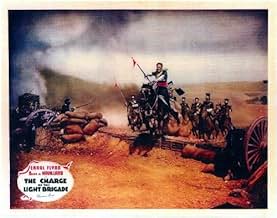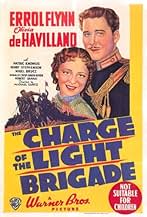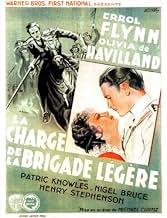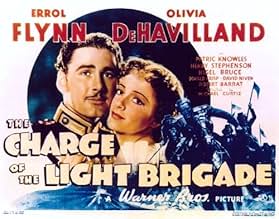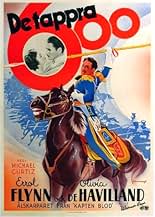La charge de la brigade légère
- 1936
- Tous publics
- 1h 55min
Suite au conflit impliquant l'Angleterre et la Russie, un officier des Indes est chargé de partir en Arabie pour fournir l'armée en chevaux. Pendant ce temps, la garnison est attaquée par le... Tout lireSuite au conflit impliquant l'Angleterre et la Russie, un officier des Indes est chargé de partir en Arabie pour fournir l'armée en chevaux. Pendant ce temps, la garnison est attaquée par le sultan Surat Khan, nouvel allié des Russes.Suite au conflit impliquant l'Angleterre et la Russie, un officier des Indes est chargé de partir en Arabie pour fournir l'armée en chevaux. Pendant ce temps, la garnison est attaquée par le sultan Surat Khan, nouvel allié des Russes.
- Réalisation
- Scénario
- Casting principal
- Récompensé par 1 Oscar
- 4 victoires et 3 nominations au total
- Major Jowett
- (as G. P. Huntley Jr.)
- Subadar-Major Puran Singh
- (as J. Carroll Naish)
- Prema's Mother
- (as Princess Baigum)
Avis à la une
The story starts in Southern California -- or rather, Northern India -- on the outskirts of the British Empire. This setting had been picked up and dusted off after 1935's "Lives of a Bengal Lancer", and would be recreated for "Gunga Din" a few years later, with the same locations and similar plots. Flynn leads a company of British lancers in skirmishes with the local rajah, the villainous Surat Khan -- you can tell he's the villain because of his evil goatee -- and a betrayal and a massacre leads to a mission of vengeance, which reaches its climax in Tennyson's Valley of Death in the Crimea.
Opposite Flynn is, naturally, Olivia deHavilland, without whom Flynn would be lost. Patric Knowles, who played Will Scarlett in Flynn's "Adventures of Robin Hood", is Flynn's brother; David Niven is his sidekick; and Henry Stephenson, Donald Crisp, and Nigel Bruce are the top brass. Director Michael Curtiz brings out another energetic performance from Flynn, although his character here lacks the depths of the heroes of "Captain Blood" or "The Dawn Patrol". Max Steiner's score complements the action perfectly.
"The Charge of the Light Brigade" is quite an epic production, and notorious for the number of horses killed in the battle scenes. That knowledge puts a bit of a damper on the excitement, but it also led to the safety restrictions in place today, banning trip-wires and ensuring the well-being of animals in movies; so, ultimately a good thing. No such measures were ever taken to protect history from the ravages of Hollywood screenwriters: Surat Khan and the country of Suristan never existed, nor did Flynn's 27th Lancers, and although there was indeed a charge at Balaklava, it didn't happen for the reasons depicted in this film. But Flynn and Curtiz didn't care, and neither should the audience.
Flynn, with his trademark moustache restored, is Major Geoffrey Vickers, dashing British Lancer, who, as the film opens, saves the life of Indian ruler Surat Khan (played by veteran screen villain C. Henry Gordon) during a tiger hunt. While Khan despises the British, he has a blood debt to Vickers, which must be honored.
Between assignments, Vickers tries to be the devoted fiancé of beautiful Elsa Campbell (de Havilland), but in a twist from the usual Flynn/de Havilland teamings, she actually loves his brother, Perry (Patric Knowles, who would later play 'Will Scarlet' in ROBIN HOOD). The love triangle subplot is the least effective part of the story; fortunately, these interludes don't last long!
Courting favor with the Russians (represented by Stalin look-alike Robert Barrat), Khan gambles, correctly, that the British would never consider him capable of murdering women and children, so his attack on an undermanned Chukoti, and the subsequent massacre of all the inhabitants (save Vickers and Campbell, thus fulfilling his blood debt), creates a furor that rocks India, and a evokes a vow of revenge from Vickers and the Lancers, who'd lost all of their loved ones. Khan flees the country, joining his Russian allies in the Crimea.
Just in time to fulfill the title, the Lancers are reassigned to the Crimea, and discover that Khan is located with the cannon emplacements on the Balaclava Heights. Arranging to get his brother safely away from the action, Vickers forges orders to have the Light Brigade attack the Heights, and 'The Charge' begins...
While the Charge (created by second unit director "Breezy" Eason) is one of the most incredible scenes ever recorded on film, with hundreds of horsemen galloping in formation 'to the guns', there was a deadly price for the spectacle; the buried explosives and trip wires used to create realistic cannon blasts injured many horses, resulting in a large number of animals having to be 'put down'. Humane societies nationwide (and Flynn, himself, who was appalled by the needless slaughter) raised such an outcry that standards were established barring cruelty to animals, which are still in effect today.
Besides Flynn's heroic performance (yes, that really IS him, leaping a cannon on horseback), Donald Crisp, Henry Stephenson, and J. Carrol Naish (as an Indian) provide memorable support. And watch for a young David Niven, as Vickers' doomed fellow officer. Flynn and Niven were great friends, sharing a cottage in Malibu (nicknamed 'Cirrhosis-by-the-Sea', because of their wild parties), and their final scene together is far more poignant than any Flynn/de Havilland moments in the film!
While flawed, historically, and unquestionably bloody, THE CHARGE OF THE LIGHT BRIGADE retains its position as a 'classic', and proved to the WB that Errol Flynn was not just a 'one hit wonder'. Great things were ahead for the young star!
Flynn has a role tailor-made to his specifications, the noble hero who looks even more splendid than ever wearing a trim mustache and military uniform. The script, in a twist, has his brother (PATRIC KNOWLES), who looks enough like Flynn to be his real brother, winning over the heart of the heroine (OLIVIA de HAVILLAND) at a military outpost in India. Flynn, as Major Vickers, decides to avenge the massacre of British women and children at the fort, thus forging the orders that lead to the famous charge.
All of it is strictly meant to entertain, offering political background of a confusing sort to give an idea of the events surrounding the charge. While all of it has been falsified for the sake of providing a screenplay that makes Flynn the noblest of heroes, there is no denying the epic sweep of the derring do and romance.
Flynn and screen partner de Havilland make a handsome couple and they are supported by a fine bunch of actors from Hollywood's British film colony, notably Patric Knowles, David Niven and Donald Crisp. Max Steiner has provided one of his best military background scores that gives added dimension to the exciting battle scenes.
For Flynn fans, this is a must see. For anyone expecting to see an historical account of the Charge, better tune in to the History Channel for that sort of stuff. But as entertainment, CHARGE OF THE LIGHT BRIGADE delivers the goods and should make Flynn and de Havilland fans happy.
Of course this is all fictional. There's no such person as the evil Moslem ruler played by C. Henry Gordon who massacred a British garrison at a place called Chukoti in 1854. The reason for the famous cavalry charge did not happen so that the regiment could get to nail this dude for his crimes. Yet one thing I found contained more than an element of truth about British rule in India and some of our problems today.
At the very beginning Errol Flynn is accompanying E.E. Clive on a goodwill mission to Gordon. It seems as though there was a treaty with a promised subsidy from Her Majesty that expired with the death of his father. Even though they're not paying him any more to be the British friend, Clive still hopes for Gordon's friendship.
This in fact was how the British acquired 'friends' all over India, they ruled very little of it outright. They won a bidding war that was as acrimonious as the military conflict with other European powers which concluded with the French out of there altogether after the Seven Years War and the Portugese left with a couple of enclaves on the coast.
Clive in fact is one very large fathead, Flynn knows it only too well. In fact though this is how we're still acquiring 'friends' in that region which is now Pakistan.
Thrown into the politics is the rivalry between Errol Flynn and his brother Patric Knowles for Olivia DeHavilland. Originally Anita Louise was supposed to be slated for the part. But after the rave notices started coming in from Captain Blood before some of the romantic stuff was to be shot, Louise was substituted for Olivia DeHavilland and poor Olivia was typecast as the crinolined heroine until she left Warner Brothers.
Jack Warner spent a lot of money on this film. The whole garrison at Chukoti where the massacre took place was built from the ground, up; no miniatures were used. Thousands of horses were bought and about 200 were destroyed in the making of the final charge. So many animals were hurt the ASPCA stepped in and Charge of the Light Brigade got a lot of bad publicity among animal lovers. It did receive an Oscar for Best Assistant Director for the second unit work in depicting the charge when that was a category at the Academy Awards.
Errol Flynn said it was the roughest film he ever made in terms of pure physicality. It was pretty rough on Olivia DeHavilland as well who Flynn accidentally cold-cocked during a scene. These crinolined heroines do have it rough.
One of my favorite character actors, Henry Stephenson, plays the fictional Charles Masefield in this film. Stephenson in every film he did always embodied the stiff upper lip, attention to your duty ethic that the United Kingdom prides itself in. He's always a man of class and refinement. And he firmly believes in the John Ford mantra, when the legend becomes fact, print the legend.
Which is what Alfred Lord Tennyson gave us when he wrote that poem extolling the young men of that generation who died at Balaclava. We're watching the legend here.
Le saviez-vous
- AnecdotesFor the filming of the climactic charge, one hundred twenty-five horses were trip-wired. Of those, twenty-five were killed outright or had to be put down afterward. The resulting public furor caused the US Congress to pass laws to protect animals used in motion pictures. Star Errol Flynn, a horseman, was so outraged by the number of horses injured and killed during the charge, and by director Michael Curtiz's seeming indifference to the carnage, that at one point as he was arguing with Curtiz about it, he could contain himself no more and actually physically attacked him. They were pulled apart before any serious damage was done, but it put a permanent freeze on their relationship; even though they made subsequent films together, they despised each other and would speak only when necessary on the set.
- GaffesAfter the massacre, Flynn sympathetically listens to Major Singh crying over the body of his murdered son Prema who is clearly wiggling his toes in the foreground of the scene.
- Citations
[first lines]
Sir Humphrey Harcourt: How do you fellows manage to look so comfortably, Vickers?
Major Geoffrey Vickers: We may look it Sir, but we're not. They say the first forty years are about the hottest up here on the frontier, after that you get used to it.
Sir Humphrey Harcourt: Really?
- Crédits fousOpening credits: This production has its basis in history. The historical basis, however, has been fictionized for the purposes of this picture and the names of many characters, many characters themselves, the story, incidents and institutions, are fictitious. With the exception of known historical characters, whose actual names are herein used, no identification with actual persons, living or dead, is intended or should be inferred.
- Versions alternativesAlso available in a computer colorized version.
- ConnexionsFeatured in Hollywood and the Stars: The Swashbucklers (1964)
- Bandes originalesGod Save the Tsar
(uncredited)
Music by Alexis Lvov
[The Russian national anthem from 1833 to 1917 played as part of the score during the charge at Balaklava]
Meilleurs choix
- How long is The Charge of the Light Brigade?Alimenté par Alexa
Détails
- Date de sortie
- Pays d’origine
- Langue
- Aussi connu sous le nom de
- La charge fantastique
- Lieux de tournage
- Lake Sherwood, Californie, États-Unis(massacre at the boats)
- Société de production
- Voir plus de crédits d'entreprise sur IMDbPro
Box-office
- Budget
- 1 200 000 $US (estimé)
- Durée
- 1h 55min(115 min)
- Couleur
- Mixage
- Rapport de forme
- 1.37 : 1



